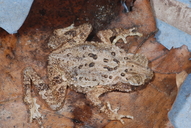|
Description
Bufo parvus is a small toad, with females of this species typically being larger than the males. Females have a snout-vent length of 40-50 mm while the males reach a snout-vent length of 30-35 mm. This toad has a short snout. A supraorbital ridge and a pair of parietal ridges are present. The skin is wrinkled and bears tubercles or warts. No tubercles are present behind the parotoid gland. The toes are half-webbed. Adult B. parvus can be brown, black, or reddish in color while the juveniles are brown in color. Adults also generally have a pair of symmetrical black spots on the mid-back. Males usually have a reddish throat (Iskandar, 1998). The tadpoles are small, with the tail usually no longer than double the head plus body length, and a denticle formula of I+1-1/III. Papillae are confined to the corner of the mouth, and the mouth is not adapted for stream-dwelling (Iskandar, 1998). Inthara et al. (2005; p. 78) provide a drawing of the larval mouthparts of Bufo parvus compared to eight other tadpole species of Thailand. Distribution and Habitat
Country distribution from AmphibiaWeb's database: Cambodia, Indonesia, Malaysia, Myanmar, Thailand Malaysian region distribution from AmphibiaWeb's database: Peninsular Malaysia
This toad occurs in forests and rubber plantations from peninsular Thailand and Burma throughout the Malay peninsula (Inger et al., 1974). It inhabits both primary and secondary forest, and can also be found in gardens (Iskandar, 1998).Life History, Abundance, Activity, and Special Behaviors
This species disperses on the forest floor more than 30 m from streams, so that the nonbreeding ranges are distinct from their breeding sites (Inger et al., 1974). Females of this species lay clutches of several hundred eggs in stagnant or slowly moving waters (Iskandar, 1998) consisting of rocky pools alongside small streams less than 10 m wide (Inger et al., 1974). Bufo parvus forms semi-isolated breeding aggregations, and calling, amplexing, and oviposition occurs at the same site (Inger et al., 1974). Trends and Threats
This species is not threatened. Comments
Bufo parvus is toxic, with skin extract doses of 100 mg/mouse causing locomotor difficulties, prostration convulsions, and death in 2 hours (Daly et al., 2004). This frog is very similar to Bornean populations of B. biporcatus in morphology and behavior (Inger et al., 1974). Bufo parvus can be distinguished by its smaller size and by the lack of tubercles behind the parotoid gland (present in B. biporcatus), as well as by having a pair of symmetrical black blotches on the back (absent in B. biporcatus) (Iskandar, 1998). The species name uses the Latin word parvus, meaning small (Iskandar, 1998).
References
Daly, J. W., Noimai, N., Kongkathip, B., Kongkathip, N., Wilham, J. M., Garraffo, H. M., Kaneko, T., Spande, T. F., Ninit, Y., Nabhitabhata, J., and Chan-Ard, T. (2004). ''Biologically active substances from amphibians: preliminary studies on anurans from twenty-one genera of Thailand.'' Toxicon, 44, 805-815.
Inger, R. F., Voris, H. K., and Voris, H. H. (1974). ''Genetic variation and population ecology of some Southeast Asian frogs of the genus Bufo and Rana.'' Biochemical Genetics, 12(2), 121-145.
Inthara, C., Lauhachinda, V., Nabhitabhata, J., Chuaynkorn, Y., and Kumtong, P. (2005). ''Mouth part structures and distribution of some tadpoles from Thailand.'' The Thailand Natural History Museum Journal, 1, 55-78.
Iskandar, D. T. (1998). The Amphibians of Java and Bali. Research and Development Centre for Biology-LIPI, Bogor, Indonesia.
Originally submitted by: Janel Marcelino (first posted 2006-04-06)
Edited by: Kellie Whittaker (2008-01-01)Species Account Citation: AmphibiaWeb 2008 Ingerophrynus parvus: Lesser Toad <https://amphibiaweb.org/species/251> University of California, Berkeley, CA, USA. Accessed Nov 22, 2024.
Feedback or comments about this page.
Citation: AmphibiaWeb. 2024. <https://amphibiaweb.org> University of California, Berkeley, CA, USA. Accessed 22 Nov 2024.
AmphibiaWeb's policy on data use.
|
